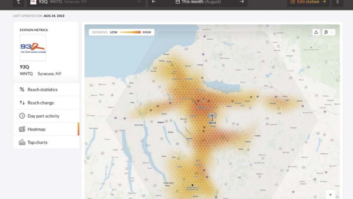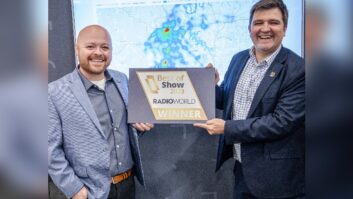DTS Inc. has been around since the early 1990s but is a relatively new name for many radio broadcasters. It has been expanding and looks to play a significant role in the broadcast and dashboard audio businesses in coming years.

Ray Sokola is responsible for new product development at DTS Inc., the new parent of HD Radio. Vice President of Technology Solutions Ray Sokola is responsible for new product development. In conjunction with his appearance at the Radio Show in Nashville in a session titled “Enhancing the Listener Experience: New Developments in Audio,” he took questions from Radio World in an email interview conducted shortly before the announcement that Tessera Technologies will acquire DTS.
An innovator in multi-channel sound, DTS — “Dedicated To Sound” — has worked with most of the world’s consumer electronics, automobile sound systems and motion picture companies. It made its first mark in motion picture sound in 1993 with the release of “Jurassic Park.” In recent years it acquired Neural Audio, a Seattle-based company that produced audio processing and multi-channel surround sound solutions for radio; it also acquired SRS Labs, Manzanita Systems and Phorus, all audio technology specialty companies.
Last year, it raised its profile in radio further by acquiring iBiquity Digital Corp., developer of HD Radio technology. In a short time, DTS has become a prominent driver of how consumers receive audio entertainment from various kinds of sources and devices.
McGinley: Tell us about your background and some of the product innovations you brought to life before you joined the company.
Sokola: I’ve been fortunate to have a career that has covered a number of exciting industries and product areas. Most of it was while I was with Motorola, which included developing technology and then running businesses. I started working on cellular technology as a fresh-out grad (before it was called cellular), and I invented the way virtually all cell phones did full duplex for about the first 20 years of cellular (all of the analog cell phone lifetime). That was an exciting start and my first Patent of the Year Award; I later followed that up with two more.
Later I ran businesses including the Motorola Ceramic Filter business and the Telematics business at Motorola and was responsible for several generations of the OnStar system for GM, including transitioning that system from analog to digital. I have also been responsible for innovations in the Connector business and Test Equipment Businesses at TE Connectivity and Wavetek, where I switched the cable TV test equipment line from analog to totally digital.
Now I enjoy bringing my business and technology experience to help develop people and organizations as well as products.
On the personal side, I played four years of varsity soccer at the University of Delaware, which I think is a key to really understanding teamwork, and am still a fan and play occasionally. I also am an active amateur radio operator with call sign K9RS. I have confirmed contacts with all of the 339 currently recognized ARRL countries.
McGinley: Your session info says you’ll discuss “new technologies and applications that promise to improve the way consumers connect with audio programs, whether at home, in the car or jogging on the beach so that in the very near future we can expect to become ever more immersed in the sound field.” That suggests a surround-sound experience, but what exactly does this mean?
Sokola: Surround sound for sure, but there is more. Consumers will be immersed in both the audio itself as well as experiences around the audio. Experiences like saving, purchasing, sharing and understanding more about the audio content and making it all relevant to the current situation of the consumer will all be part of the future.
McGinley: Give us a few key bullet-points.
Sokola: Hybrid radio — the connection of traditional radio with the internet. This expands the listening experience to take advantage of the best of the past, present and future capabilities that cellular connectivity, the internet, streaming and apps have added to the traditional radio experience. The basic examples start with providing album art and easy purchase capability to a radio experience, but it goes way beyond that and is only limited by our imagination.
Context enhancement — taking into account the contextual information to optimize the experience. Historical and current status inputs provide context that can be used to modify and improve our experience as consumers. Optimizing noise reduction and background audio enhancement, such as enhancing voice characteristics during phone calls and minimizing rain and wiper noise while driving, are just a few simple examples of context enhancement.
Augmented reality — mixing reality in with entertainment and information in just the right way. If an ambulance is coming from behind, and the sensors on the car detect that, the sound from that can be a higher priority and the music etc. can be lower. So the car can modulate the amount of “reality” for the driver and passengers depending on the situation.
Data sonification — making data available in an audio format. Getting information like speed, gas level, tire pressure or overall car health through an audio indication instead of gauges.
McGinley: As one charged with seeing and developing possibilities for technology, how do you anticipate that new forms of audio listening will evolve over two to five years?
Sokola: Hybrid radio is a platform for innovation that can be taken anywhere by creating the right connection between the radio, the internet, the rest of the vehicle, the auto manufacturer and the consumer. That, I think, will evolve in many ways.
Some simpler and nearer-term areas of evolution include voice audio, both for commands and understanding using further contextual awareness.
I also see the radio system using sensing more to provide the consumer with what they need. If driving a car, awareness changes based on the auto and driver status; if running on foot, more situational awareness to minimize danger and allow the “right” amount of outside information in, like car noise, sirens etc.
McGinley: So many audio connected devices nowadays use earbuds as closed field stereo transducers. Yet a surround-sound experience can be created in such a binaural environment. Explain how that’s achieved.
Sokola: The simple explanation is that we have just two ears and hear surround sound. Our ears process the phase and amplitude relationships of sounds so that we can tell where the sound is coming from. We just process the sound that way and present it to the ears with the phases and amplitudes already set.
McGinley: Video games and the internet have led the way in engaging consumers in interactive entertainment content. Can an interactive audio experience for consumers truly be created with any of your new innovations and if so, how?
Sokola: Sure, there are many ways the interaction can occur. Short-term simple interactions using hybrid radio can include feedback to radio stations on polls or data on level of agreement with talk radio discussions. I also think we will see apps that are now text-oriented combine with or move to more audio, which would be easier to consume without having to look at a screen. Longer-term augmented and virtual reality will play a bigger role, particularly with self-driving vehicles.
McGinley: We understand that HD Radio is expanding its reach and penetration annually. Forty percent of new cars delivered in 2015 had receivers installed. But what does the combination of DTS and HD Radio bring us next that we haven’t already heard about? And what can broadcasters get excited about next in terms of the technical platform’s capabilities?
Sokola: The combination of DTS and HD Radio technology brings several advantages, including fresh eyes, a global platform, more business flexibility and a larger development organization that is dedicated to sound and “Making the World Sound Better.” More immersive surround sound with an HD Radio receiver is just one example, but I think a broader perspective of combining the technology with the internet and with additional car sensors as described with augmented reality and data sonification will lead to some exciting things for broadcasters that will let them bring a better experience, as well as measure engagement in ways that they can’t today.
McGinley: Radio has seen various multi-channel and surround-sound technologies come and go. A few broadcast processor companies have tried to introduce their own solutions since Lou Dorren offered FM Quadraplex 47 years ago, but nothing has really stuck. I’ve got to think DTS has a solution for this unrealized opportunity.
Sokola: We can and do up-mix and process stereo audio to beyond stereo and provide surround-sound effects with modest speaker systems or headphones both in and out of vehicles. These effects can be further optimized with HD Radio broadcasts.
McGinley: Ford recently announced the “Dual Radio Reception” innovation for several new car models that provides almost seamless HD Radio reception in vehicles. Tell us how that DTS innovation works.
Sokola: “Dual Radio Reception” is a form of diversity called maximal ratio combining. It minimizes or eliminates fading by using two receivers and combining them to take advantage of the high probability that both will not be subjected to fading at the same time. It effectively improves range and performance.
McGinley: What about NextRadio and other FM radio apps for smartphones? What opportunities does DTS see to engage and further develop that platform?
Sokola: DTS mobile solutions improve the audio experience on a device, regardless of the delivery or transmission of audio. In addition, we have a longstanding relationship with the team at NextRadio and are actively collaborating to bring combined functionality into a vehicle.
McGinley: What can you say to those radio broadcasters who have not yet implemented FM HD Radio, especially in smaller markets, about whether it is worth doing and whether the technology will survive and thrive?
Sokola: Simple. Radio is the only consumer medium still not fully digital. Consumers have come to expect that all their audio and video entertainment sources will have added features and digital quality. If a radio station can’t offer Artist Experience visuals for album art, station logo and advertiser value-added, they are last century’s medium in the eyes of today’s sophisticated consumer.
Being able to replicate the audio experience already available on your phone or iPod is becoming not just a novelty but a necessity to compete in today’s wired world. There is no question that the technology will survive and prosper. Those of your readers old enough to remember the advent of FM stereo in the late ’60s may remember the same arguments being made against FM in general and FM stereo in particular.
There is no criticism made of HD Radio technology that wasn’t made about FM back in the day. The big difference is that FM only doubled or tripled the number of audio sources available to listeners. Now there are literally hundreds of audio sources available to the consumer as close as their telephone. In the same way that transmitting a high-quality stereo FM became the cost of doing business by the mid ’70s, transmitting a digital quality signal with graphics and metadata is rapidly becoming necessary to compete effectively in all but the very smallest markets. It’s also worth noting that the cost to go from FM mono to FM stereo in the ’60s was about the same as upgrading to HD Radio technology now, calculated in today’s dollars.
McGinley: What about AM HD Radio broadcasting? Is the all-digital MA-3 mode the best way to “save” the AM radio service?
Sokola: We’ve worked with the industry to evaluate the performance of all-digital AM HD Radio broadcasts and the results were strong. All-digital AM is a natural transition for our current AM solution and we see it benefiting the industry in the future.
McGinley: What other related enterprises is DTS considering to add to its portfolio?
Sokola: There aren’t any that I can mention right now but “stay tuned.”
Comment on this or any story. Email[email protected].
The Radio Show also will feature DTS Chairman/CEO Jon Kirchner discussing the future of radio and its global and local impact.











